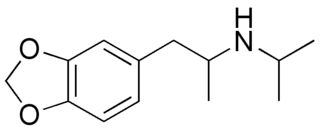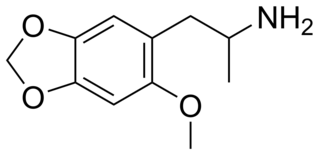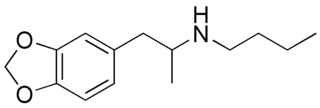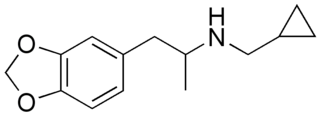
2C-G is a psychedelic phenethylamine of the 2C family. First synthesized by Alexander Shulgin, it is sometimes used as an entheogen. It has structural and pharmacodynamic properties similar to 2C-D and Ganesha. Like many of the phenethylamines in PiHKAL, 2C-G and its homologs have only been taken by Shulgin and a small test group, making it difficult to ensure completeness when describing effects.

MMDA is a psychedelic and entactogen drug of the amphetamine class. It is an analogue of lophophine, MDA, and MDMA.

3,4-Methylenedioxy-N-methoxyamphetamine is a lesser-known psychedelic drug and a substituted amphetamine. It is also the N-methoxy analogue of MDA. MDMEO was first synthesized by Alexander Shulgin. In his book PiHKAL , the minimum dosage is listed as 180 mg. MDMEO may be found as white crystals. It produces few to no effects. Very little data exists about the pharmacological properties, metabolism, and toxicity of MDMEO.
MDMEOET, or 3,4-methylenedioxy-N-methoxyethylamphetamine, is a lesser-known psychedelic drug and a substituted amphetamine. It is also the N-methoxyethyl analogue of MDA. MDMEOET was first synthesized by Alexander Shulgin. In his book PiHKAL , the minimum dosage is listed as 180 mg. MDMEOET produces few to no effects. Very little data exists about the pharmacological properties, metabolism, and toxicity of MDMEOET.

3,4-Methylenedioxy-N-hydroxyamphetamine is an entactogen, psychedelic, and stimulant of the phenethylamine and amphetamine chemical classes. It is the N-hydroxy homologue of MDA, and the N-desmethyl homologue of MDHMA. MDOH was first synthesized and assayed by Alexander Shulgin. In his book PiHKAL, Shulgin listed the dosage range as 100–160 mg, and the duration as approximately 3–6 hours. He describes MDOH as being very psychedelic and producing increased pleasure in beauty and nature. He also mentioned several negative side effects also seen with MDMA ("Ecstasy") such as difficulty urinating and internal dryness.

3,4-Methylenedioxyphentermine (MDPH) is a lesser-known psychedelic drug. MDPH was first synthesized by Alexander Shulgin. In his book PiHKAL , the dosage range is listed as 160–240 mg, and the duration as 3–5 hours. MDPH's effects are very similar to those of MDA: they both are smooth and "stoning," and do not cause any visuals. They also alter dreams and dream patterns. Shulgin describes MDPH as a promoter; it promotes the effects of other drugs, similarly to 2C-D. Very little data exists about the pharmacological properties, metabolism, and toxicity of MDPH.

3,4-Ethylenedioxy-N-methylamphetamine (EDMA) is an entactogen drug of the methamphetamine class. It is an analogue of MDMA where the methylenedioxy ring has been replaced by an ethylenedioxy ring. EDMA was first synthesized by Alexander Shulgin. In his book PiHKAL, the dosage is listed as 150–250 mg, and the duration listed as 3–5 hours. According to Shulgin, EDMA produces a bare threshold consisting of paresthesia, nystagmus, and hypnogogic imagery, with few to no other effects. Scientific research has demonstrated that EDMA acts as a non-neurotoxic serotonin releasing agent with moderately diminished potency relative to MDMA, and with negligible effects on dopamine release.

2-Bromo-4,5-methylenedioxyamphetamine (6-Bromo-MDA) is a lesser-known psychedelic drug and a substituted amphetamine. It was first synthesized by Alexander Shulgin. In his book PiHKAL, the dose is listed as 350 mg and the duration unknown. It produces stimulant effects but with no psychedelic or empathogenic action. Very little data exists about its pharmacological properties, metabolism, and toxicity.

1,3-Benzodioxolylbutanamine is an entactogenic drug of the phenethylamine chemical class. It is the α-ethyl analog of MDPEA and MDA and the methylenedioxy analogue of α-ethylphenethylamine.

MDHOET, or 3,4-methylenedioxy-N-hydroxyethylamphetamine, is a lesser-known psychedelic drug and a substituted amphetamine. It is also the N-hydroxyethyl analogue of MDA. MDHOET was first synthesized by Alexander Shulgin. In his book PiHKAL , the minimum dosage is listed as 50 mg. MDHOET produces few to no effects. Very little data exists about the pharmacology, pharmacokinetics, effects, and toxicity of MDHOET.

3,4-Methylenedioxy-N-isopropylamphetamine is a psychoactive drug of the phenethylamine and amphetamine chemical classes which acts as an entactogen, psychedelic, and stimulant. It is the N-isopropyl analogue of 3,4-methylenedioxyamphetamine (MDA). MDIP was first synthesized by Alexander Shulgin. In his book PiHKAL, the minimum dosage is listed as 250 mg. MDIP produces a mild threshold. Very little is known about the pharmacology, pharmacokinetics, effects, and toxicity of MDIP.

MMDA-2 (2-methoxy-4,5-methylenedioxyamphetamine) is a psychedelic drug of the amphetamine class. It is closely related to MMDA and MDA.

N-Methyl-2-methoxy-4,5-methylenedioxyamphetamine is a psychedelic drug of the amphetamine class. It is the N-methylated derivative of MMDA-2, and it is also an analog of MDMA and 6-methyl-MDA.

Methylenedioxyallylamphetamine is a lesser-known psychedelic drug. It is also the N-allyl derivative of 3,4-methylenedioxyamphetamine (MDA). MDAL was first synthesized by Alexander Shulgin. In his book PiHKAL, the minimum dosage is listed as 180 mg, and the duration unknown. MDAL produces few to no effects on its own, but may enhance the effects of LSD. Very little data exists about the pharmacological properties, metabolism, and toxicity of MDAL.

Methylenedioxybutylamphetamine is a lesser-known psychedelic drug. It is also the N-butyl derivative of 3,4-methylenedioxyamphetamine (MDA). MDBU was first synthesized by Alexander Shulgin. In his book PiHKAL, the minimum dosage is listed as 40 mg, and the duration unknown. MDBU produces few to no effects. Very little data exists about the pharmacological properties, metabolism, and toxicity of MDBU.

MDBZ, or 3,4-methylenedioxy-N-benzylamphetamine, is a lesser-known psychedelic drug. It is the N-benzyl derivative of MDA. MDBZ was first synthesized by Alexander Shulgin. In his book PiHKAL , the minimum dosage is listed as 150 mg, and the duration unknown. MDBZ produces few to no effects. Very few data exist about the pharmacological properties, metabolism, and toxicity of MDBZ.

MDCPM, or 3,4-methylenedioxy-N-cyclopropylmethylamphetamine, is a lesser-known psychedelic drug. It is the N-cyclopropyl derivative of MDMA. MDCPM was first synthesized by Alexander Shulgin; it is also one of the compounds delineated in a patent by Horrom in 1972. In his book PiHKAL , the minimum dosage is listed as 10 mg, and the duration unknown. MDCPM produces few to no effects. Very little data exists about the pharmacological properties, metabolism, and toxicity of MDCPM.

3,4-Methylenedioxy-N,N-dimethylamphetamine (MDDM) is a lesser-known psychedelic drug. It is also the N,N-dimethyl analog of 3,4-methylenedioxyamphetamine (MDA). MDDM was first synthesized by Alexander Shulgin. In his book PiHKAL , the dosage is unspecified and the duration unknown. MDDM produces only mild effects that are not well characterized in PiHKAL. Very little data exists about the pharmacological properties, metabolism, and toxicity of MDDM. This compound is however occasionally encountered as an impurity in 3,4-methylenedioxy-N-methylamphetamine (MDMA) which has been synthesized by methylation of MDA using methylating reagents such as methyl iodide. An excess of reagent or a reaction temperature that is too high results in some double methylation of the amine nitrogen, yielding MDDM as well as MDMA. The presence of MDDM as an impurity can thus reveal which synthetic route was used to manufacture seized samples of MDMA.

3,4-Methylenedioxyphenethylamine, also known as homopiperonylamine, is a substituted phenethylamine formed by adding a methylenedioxy group to phenethylamine. It is structurally similar to MDA, but without the methyl group at the alpha position.

1-Methylamino-1-(3,4-methylenedioxyphenyl)propane or M-ALPHA is an empathogen, reported by Alexander Shulgin in his book PIHKAL as a positional isomer of MDMA, and subsequently found being sold as a designer drug in the UK in 2010, and reported to the EMCDDA new drug monitoring service. It was described by Alexander Shulgin as similar in action to its demethylated homologue, ALPHA, but with roughly twice the duration and twice the potency.



















